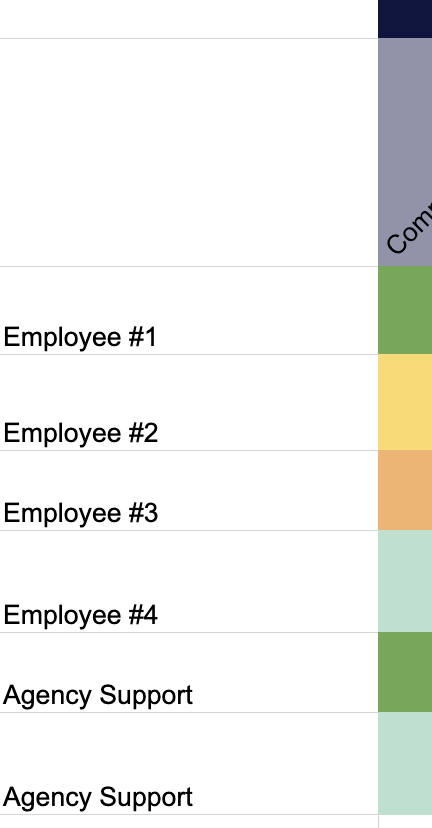Marketing Managers: Do You Have a Skills Matrix For Your Team
In one of my first jobs out of college, I remember my manager going through an exercise with our team which – at the time – felt like the most bureaucratic, political waste of time ever: The Skills Matrix.
If you’re not familiar, a skills matrix is exactly what it sounds like: A spreadsheet that outlines all of the skills needed for the team, and how each team member stacks up in each area. (Hang with me, I promise it’s not as boring as it sounds).
Back then, when I had no clue what managing a team entailed, I dismissed the exercise. After all, I was just there to do the stuff on my to-do list, and take advantage of the free snacks in the break room. But as time has gone on, and I have had the opportunity to build, manage, and lead teams of all different shapes and sizes, I’ve found that this is one of the most important tools in a modern manager’s toolkit. And here’s why:
(Pro tip: if you want to bypass all this mumbojumbo, and just download a skills matrix template to get started, just jump down to the Skills Matrix Download!)
X Axis: The Outputs of Your Team
At the end of the day, a team is simply a group of people within a company who are collectively responsible for delivering a certain set of outputs. For digital marketing teams, this includes things like: strategic roadmaps, PPC management, web design, copywriting, SEO strategy, email marketing, and more. But even within each of those categories are multiple facets – for example, SEO requires keyword research, technical SEO, SEO copywriting, and a degree of analytics.
When you map out the actual deliverables of your digital marketing team, you’ll find that as the marketing manager, you oversee a LOT of unique skills-based deliverables – many of which are split and shared among multiple people. Jim may be a brilliant SEO researcher, but may have the copywriting skills of a robot – not exactly who you want to be writing your marketing material.
So, the company demands certain outputs from your team – that’s one axis of the matrix. No matter who is on your team, or how many roles you oversee, the outputs expected of your group is relatively objective. On the opposite axis are your people.
Y Axis: Your People
When you hire someone – no matter what role you hire them for – it’s important to understand (and document) the full range of their capabilities and skill sets. And to go even further, you need to understand their degree of expertise in each of those categories. If you’re hiring correctly, the majority of these skills should line up directly with the role – but it’s important to explore other skills as well, and the team member may be interested in growing into a new role at some point down the road.
Without some sort of diagram like a skills matrix, there is no way to track each individual’s strengths and weaknesses with any sort of organization or structure. (No, your Evernote file on each team member isn’t going to cut it).
Now Complete the Matrix
Collaboratively with each member of your team, fill in each cell of the matrix with a “Score.” It's important that your team understands this is NOT a performance review. This is not a time to exaggerate competence in any particular area in order to ‘look good’ or appear ambitious. The more accurate the representation in each cell, the better. This is the only way that you as the marketing manager will have confidence in your team’s ability to realistically deliver across the board.
I like to use a scale from 1-100 (sticking to round numbers like 0, 25, 50, 75, 100) with the following range definitions:
0: Indicates that this task isn’t a part of the team member’s skillset. Ideally, this is used for tasks that aren’t a part of the person’s job description.
25: Indicates that this team member has a novice-level knowledge of the task. They may be able to assist others in this area, but can’t work independently.
50: Indicates an intermediate skill level. This user has demonstrated high levels of skills in this area, and can handle tasks independently.
75: Indicates an expert skill level. This can be your go-to person for this task, and they can lead this component of campaigns.
100: Indicates a mastery of the skill level, and the ability to not only lead projects, but also mentor and coach others.
Look for Completeness Vertically, and Growth Opportunities Horizontally
When you have completed the matrix (I like to apply conditional formatting to color each cell depending on the grade), it’s your turn to assess the results of the matrix.
Vertically, you can get a quick understanding of the ‘coverage’ of each expected output of your team. For example, if your team is expected to manage Paid Social Campaigns, but the cells below this discipline are all 0s, you have a crystal clear case for either: 1. An additional resource – whether an employee or an agency, or 2. Professional development and expansion of a current team member’s role. (A less ambitious, but equally viable 3rd option is to transfer this discipline to another manager’s team).
Even if you have 1 ‘100’ cell under every discipline within your team (which is a great start), it’s also important to think about the “bench strength” of the team. That is – is there a team member with a 50 or 75 score in the column as well? If not, what’s the plan if your expert gets hit by the proverbial bus in the middle of a campaign? You don’t need tons of redundancy at every level, but it is very important to look for weak links in the chain, and proactively drive professional development to improve the depth of the bench on a particular skill.
Horizontally, you get to be an amazing ‘people leader.’ If there's an area where the team is light on skills, but a team member finds it interesting, this is a great way to help your employee continue to grow in the ways that bring them joy and give them a feeling of contribution.
A note to bad managers: Don’t mistake the above statement as a push to “do more with less,” or burden existing employees with new responsibilities that they don’t want, or without compensating them appropriately. If a team member is stepping up to a new opportunity, it’s your job to make sure they are rewarded and supported.
And there you have it – The Skills Matrix! I promise that if you give this exercise the attention it deserves, you will find increased clarity, increased productivity, and a much more predictable delivery of your team’s outputs.







